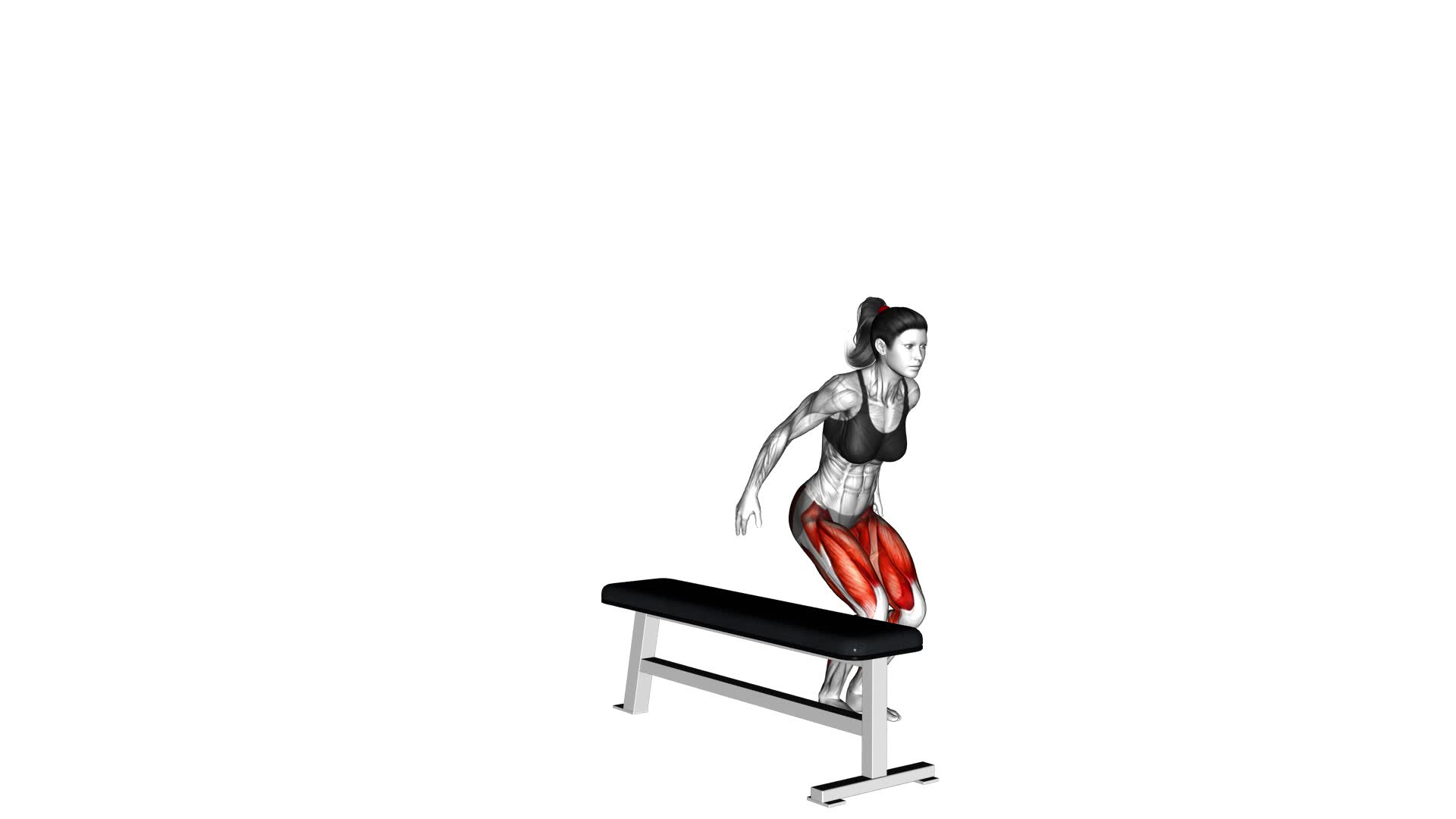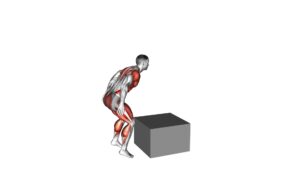Lateral Box Jump (female) – Video Exercise Guide & Tips

Are you looking to add a challenging and effective exercise to your fitness routine? Look no further than the Lateral Box Jump!
Watch This Exercise Video
In this video exercise guide, we'll show you proper form and technique, variations and progressions, and common mistakes to avoid.
Get ready to improve your lower body strength, explosiveness, and stability. Whether you're a beginner or advanced, this exercise is a great addition to any workout.
Let's jump right in!
Key Takeaways
- The lateral box jump improves explosive power and agility.
- It strengthens leg muscles, including the quadriceps, hamstrings, and glutes.
- Incorporating lateral box jumps into circuit or interval training can improve cardiovascular fitness.
- It is important to maintain proper form and technique, including a strong and stable core and using the arms for momentum.
Benefits of the Lateral Box Jump
You can improve your explosive power and agility by incorporating lateral box jumps into your workout routine. Lateral box jumps are an effective exercise that can help you achieve improved agility and cardiovascular fitness. These jumps require you to explosively jump from one side of a box to the other, engaging your lower body muscles and challenging your balance and coordination.
By regularly performing lateral box jumps, you can enhance your agility, which is the ability to change direction quickly and efficiently. This exercise strengthens the muscles in your legs, including your quadriceps, hamstrings, and glutes, allowing you to generate more power in your movements. As a result, you'll be able to move faster and more effectively in sports and everyday life.
Additionally, lateral box jumps provide a cardiovascular workout. The explosive nature of this exercise elevates your heart rate, increasing your endurance and stamina over time. This makes it a great addition to any cardio-focused routine.
To maximize the benefits of lateral box jumps, start with a lower box height and gradually increase the height as you become more comfortable and proficient. Always maintain proper form, land softly on the box, and focus on exploding off the ground with each jump.
Incorporating lateral box jumps into your workout routine will help you improve your agility and cardiovascular fitness, allowing you to perform at your best.
Proper Form and Technique
To ensure proper form and technique during a lateral box jump, focus on maintaining a strong and stable core throughout the movement. This is crucial for improving your vertical jump and increasing explosiveness.
Start by standing next to the box with your feet shoulder-width apart and your knees slightly bent. As you prepare to jump, hinge at the hips and lower your body into a quarter squat position. Swing your arms back for momentum and then explosively jump laterally onto the box, extending your hips and knees. Land softly on the box, absorbing the impact with a slight bend in your knees. Keep your chest up and your core engaged to maintain stability.
As you jump down from the box, land softly with a slight bend in your knees to minimize stress on your joints. Remember to always land and take off from the box with both feet at the same time.
By focusing on maintaining proper form and technique, you can maximize the benefits of the lateral box jump.
Now let's explore some variations and progressions to keep challenging yourself and continue improving.
Variations and Progressions
To progress and challenge yourself with the lateral box jump, try incorporating different variations.
There are several advanced variations and training progressions that can take your lateral box jump to the next level. One option is to increase the height of the box. Start with a lower box and gradually work your way up to a higher one as you build strength and confidence.
Another variation is to add weights to the exercise. You can hold dumbbells or wear a weighted vest to increase the resistance and make the jump more challenging.
Additionally, you can incorporate lateral box jumps into a circuit or interval training routine, alternating them with other exercises to keep your heart rate up and maximize your workout.
By incorporating these advanced variations and training progressions, you can continue to challenge your muscles and improve your athletic performance.
Now, let's move on to the next section and discuss some common mistakes to avoid during the lateral box jump.
Common Mistakes to Avoid
One common mistake to steer clear of during the lateral box jump is jumping too far out or too close to the box. It's important to find the right distance to ensure a safe and effective jump. If you jump too far out, you may not have enough power to land on the box, which can lead to injury. On the other hand, jumping too close to the box can cause your feet to hit the edge, resulting in loss of balance and potential accidents.
Another common mistake to avoid is neglecting proper landing technique. When landing from a lateral box jump, make sure to bend your knees and absorb the impact by landing softly. Landing with stiff legs can put unnecessary strain on your joints and increase the risk of injury. It's also important to maintain good form throughout the exercise. Keep your core engaged, chest up, and back straight. This will help you generate power and stability, allowing for a more efficient and controlled jump.
In summary, common mistakes to avoid during the lateral box jump include jumping too far out or too close to the box, neglecting proper landing technique, and failing to maintain good form. By being mindful of these technique tips, you can maximize the benefits of this exercise while minimizing the risk of injury.
Now, let's move on to the next section, where we'll discuss safety precautions and tips to keep in mind while performing the lateral box jump.
Safety Precautions and Tips
To ensure a safe and effective lateral box jump, it's important to follow these safety precautions and tips:
- Warm up before performing lateral box jumps:
Warming up is crucial to prepare your muscles and joints for the intense movements involved in box jumps. Start with light cardio exercises like jogging or jumping jacks, followed by dynamic stretches targeting your lower body.
- Choose the right height for the box jump:
The height of the box should challenge you without compromising your safety. Start with a lower height and gradually increase as your strength and technique improve. A good rule of thumb is to choose a box height that allows you to maintain proper form throughout the exercise.
- Use proper landing technique:
When jumping onto the box, land with your knees slightly bent to absorb the impact. Avoid landing with your knees locked or in a deep squat position, as this can put excessive strain on your joints.
- Listen to your body and progress at your own pace:
Pay attention to any discomfort or pain during the exercise. If you experience any sharp or intense pain, stop immediately and consult a healthcare professional. Progress gradually, allowing your body to adapt and build strength over time.
Frequently Asked Questions
How Many Calories Can You Burn by Doing Lateral Box Jumps?
By doing lateral box jumps, you can burn a significant amount of calories. This exercise engages multiple muscle groups, including your legs, glutes, and core, resulting in a high calorie burn.
In addition to the calorie-burning benefits, lateral box jumps also improve your cardiovascular fitness, agility, and explosiveness.
Incorporating this exercise into your routine can help you achieve your weight loss or fitness goals while challenging your body in a different way.
Can Lateral Box Jumps Help Improve Vertical Jumping Ability?
Lateral box jumps can definitely help improve your vertical jumping ability. By incorporating lateral box jumps into your training routine, you can enhance your agility and explosiveness, which are key components of a higher vertical jump.
The benefits of lateral box jumps include strengthening your leg muscles, improving coordination, and increasing power output. So, if you want to take your vertical jump to the next level, give lateral box jumps a try!
What Muscles Are Targeted During a Lateral Box Jump?
During a lateral box jump, several muscles are targeted. The primary muscles worked include the quadriceps, hamstrings, glutes, and calf muscles. These muscles work together to generate explosive power and stability during the jump.
Additionally, the lateral movement engages the hip abductor muscles, which play a crucial role in maintaining balance and control.
Performing different variations of lateral box jumps can provide various benefits, such as improving agility, increasing lower body strength, and enhancing overall athletic performance.
Are Lateral Box Jumps Suitable for Beginners?
Lateral box jumps can be a challenging exercise for beginners. It's important to consider your fitness level and any previous injuries before attempting this exercise. If you're a beginner, there are alternatives you can try that are less intense and easier to perform.
Step-ups, lateral lunges, or side shuffles are great options to build strength and coordination before progressing to lateral box jumps. Always consult with a fitness professional to ensure you're using proper form and technique to prevent injury.
How Often Should Lateral Box Jumps Be Incorporated Into a Workout Routine?
Incorporating lateral box jumps into your workout routine can provide several benefits. They help improve your lower body strength, power, and agility.
As for the frequency, it's recommended to include them 2-3 times a week. However, it's important to listen to your body and adjust accordingly. Start with a lower number of repetitions and gradually increase as you become more comfortable and stronger.
Remember to always warm up properly and maintain proper form to prevent injuries.
Conclusion
In conclusion, the lateral box jump is a highly effective exercise for improving explosiveness, agility, and lower body strength. By maintaining proper form and technique, you can maximize the benefits of this exercise.
It's important to progress gradually and avoid common mistakes to prevent injury. Following safety precautions and tips will ensure a safe and effective workout.
Incorporate the lateral box jump into your training routine to enhance your athletic performance.

Author
Years ago, the spark of my life’s passion ignited in my mind the moment I stepped into the local gym for the first time. The inaugural bead of perspiration, the initial endeavor, the very first surge of endorphins, and a sense of pride that washed over me post-workout marked the beginning of my deep-seated interest in strength sports, fitness, and sports nutrition. This very curiosity blossomed rapidly into a profound fascination, propelling me to earn a Master’s degree in Physical Education from the Academy of Physical Education in Krakow, followed by a Sports Manager diploma from the Jagiellonian University. My journey of growth led me to gain more specialized qualifications, such as being a certified personal trainer with a focus on sports dietetics, a lifeguard, and an instructor for wellness and corrective gymnastics. Theoretical knowledge paired seamlessly with practical experience, reinforcing my belief that the transformation of individuals under my guidance was also a reflection of my personal growth. This belief holds true even today. Each day, I strive to push the boundaries and explore new realms. These realms gently elevate me to greater heights. The unique combination of passion for my field and the continuous quest for growth fuels my drive to break new ground.







